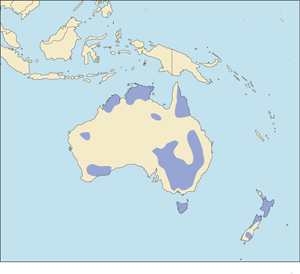Feral Goat - South Pacific | Online Record Book Preview
This is a preview of the Feral Goat - South Pacific species only.
Once you subscribe you will be able to view all the entry details for hundreds of different species, including full score sheets and photos.
This species has several classifications, to view each one you can click on the links below to jump down to that section:
Feral Goat - South Pacific |
 |
Capra hircus
Cabra cimarrón (Sp), Wildziege (G), Chèvre sauvage (F).
These are domestic goats living in the wild, either because of releases or escapes from confinement. Goats were first domesticated 8,000-9,000 years ago in southwestern Asia and are generally considered to be directly descended from the bezoar ibex or wild goat (Capra aegagrus). Domestic goats have been transported throughout the world by humans, and have become feral in many areas.
DESCRIPTION (male) Shoulder height 24-35 inches (60-90 cm), weight 66-150 pounds (30-68 kg). Females are somewhat smaller. As in all goats, the chromosome number is 60.
Goats are sturdy, powerful animals with an outer coat of coarse hair and an undercoat of fine wool. Many domestic breeds were introduced in the South Pacific region and have interbred where they have come in contact, producing a wide variety of colors, body sizes and horn configurations. The main coat color may be white, gray, brown, black, or any combination of these in every conceivable pattern. Adult males and some females grow a chin beard, which also varies widely in color. Horns (usually in both sexes) may be either scimitar-shaped or outwardly spiraling. The horns have ridges and annual growth rings.
BEHAVIOR Primarily browsers rather than grazers (the opposite of sheep), feral goats are diurnal, gregarious and prolific, and herds as large as 500 have been recorded, although the average is 6-20. Males and females usually form separate herds. Goats tend to feed early and late, bedding in the sun on rocky ledges during the day. Will climb trees in order to feed in the branches. Eyesight, sense of smell and hearing are all good.
HABITAT All types.
DISTRIBUTION Scattered throughout Australia, New Zealand, and many South Pacific islands. Under Free Range and Estate conditions.
REMARKS Domestic goats first reached New Zealand in 1773 with Captain Cook, and Australia's Botany Bay in 1788 with early settlers. Many undoubtedly escaped or were set free, but deliberate attempts to establish feral populations were made in the early 19th century. Now widely established in Australia, New Zealand and many South Pacific islands, feral goat populations persist despite long-term government programs to eradicate them. Called "every man's big game" by Allison and "poor man's big game" by Penfold, more than two million have been shot by cullers, landowners and sportsmen since 1937. Plentiful and not especially difficult to hunt, feral goats are a good choice for the beginning hunter.
|
Classifications
Feral Goat (free range) - Species Detail |
| Scientific Name: |
Capra hircus |
Gold: |
75 5/8" |
Gold (Bow): |
70 4/8" |
| AKA: |
|
Silver: |
66 7/8" |
Silver (Bow): |
53 4/8" |
| Endangered: |
|
Bronze: |
55" |
Bronze (Bow): |
49" |
| Member |
Taken |
Location |
Hunting Company/Guide |
Measurer |
MOK |
Score |
OR |
MR |
The Feral Goat (free range) currently has 426 Entries listed in the SCI Record Book!
Once you subscribe you'll be able to access photos and full socre sheets for all of these entries. Plus you can filter, sort, and search through all species and entries in the SCI database. If you would like to subscribe now to have access to the entire database, please click here.
|
Return to Top
Feral Goat - Species Detail |
| Scientific Name: |
Capra hircus |
Gold: |
71 5/8" |
Gold (Bow): |
63 4/8" |
| AKA: |
|
Silver: |
66 7/8" |
Silver (Bow): |
53 4/8" |
| Endangered: |
|
Bronze: |
59" |
Bronze (Bow): |
53" |
| Member |
Taken |
Location |
Hunting Company/Guide |
Measurer |
MOK |
Score |
OR |
MR |
The Feral Goat currently has 147 Entries listed in the SCI Record Book!
Once you subscribe you'll be able to access photos and full socre sheets for all of these entries. Plus you can filter, sort, and search through all species and entries in the SCI database. If you would like to subscribe now to have access to the entire database, please click here.
|
Return to Top
|




